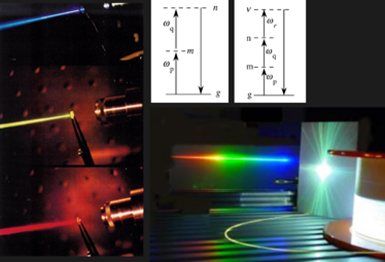
Maxwell’s equations in linear and nonlinear
media, 2nd and 3rd -order optical nonlinearities, nonlinear
crystals, phase-matching, frequency conversion techniques, stimulated
scattering, self-phase modulation, pulse compression, solitons.
This course studies the interaction of intense light with optically
transparent media when the interaction becomes non-linear, that is, when
Newton’s principle of superposition ceases to operate. Starting with Maxwell’s
equations, the course develops the formalism of nonlinear optics, introducing
the concept of nonlinear susceptibility, explained using both a simple
mechanical analogy and quantum mechanical perturbation theory. The goal is to
equip students with knowledge about non-linear effects of different (2nd,
3rd, etc.) orders, about non-linear materials, and how they can
apply non-linear optical effects to various experimental scenarios.
Pre-requisites: Graduate
Standing and Consent of Instructor
Suggested
Reading
- R. W.
Boyd, Nonlinear Optics, 4-th Ed. (Acad. Press, 2020)
- G.I.
Stegeman, R.A. Stegeman, Nonlinear Optics Phenomena, Materials, and
Devices (Wiley, 2012)
Topics
- Maxwell’s equations in nonlinear media
- Nonlinear susceptibility based on
a classical anharmonic oscillator analogy
- Nonlinear susceptibility based on the quantum-mechanical
perturbation theory
- Coupled-wave
equations for nonlinear optical interactions
- Nonlinear optical crystals
with 2nd-order
susceptibility
- Phase matching in nonlinear
optical interactions
- Quasi-phase-matching
(QPM)
- Sum-frequency and 2nd-harmonic
generation. Difference-frequency generation.
- Conversion
efficiency of nonlinear optical processes
- Optical parametric
oscillators (OPOs) and amplifiers (OPAs). Tuning curves.
- Nonlinear effects
inside a resonant cavity
- Nonlinear optics
with ultrafast optical pulses.
- 3rd-order
nonlinear susceptibility χ(3)
and its tensor representation
- Kerr effect.
Intensity-dependent refractive index. Self-focusing. Self-phase modulation.
- Parametric
processes due to 4-wave mixing. 3rd harmonic generation.
- Phase conjugation,
two-photon absorption, all-optical switching
- Techniques for
measuring 2nd and 3rd -order nonlinearities. Z-scan.
- Stimulated
Brillouin scattering. Stimulated Raman scattering
- Cascaded χ(2)
effects.
- Nonlinear
Schrödinger equation. Solitons.Bottom of Form